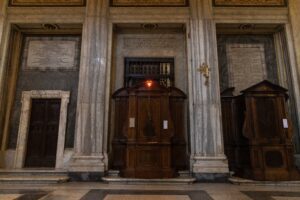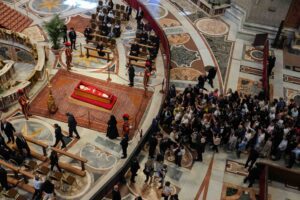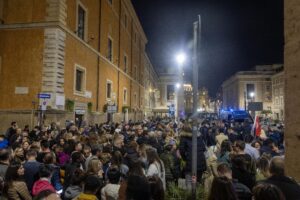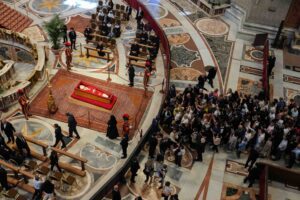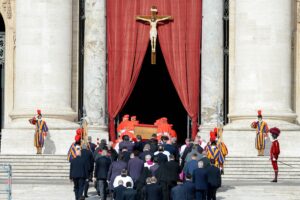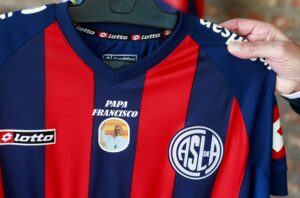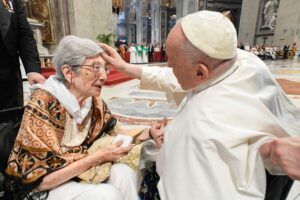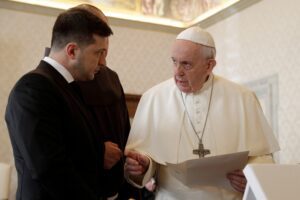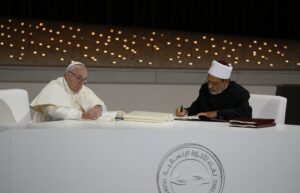SCRANTON – Faithful of the Diocese of Scranton woke up Easter Monday morning to the news that Pope Francis had passed away during the night at his residence in Vatican City at the age 88 – less than 24 hours after he conferred what would be his final “Urbi et Orbi” blessing on Easter Sunday in Rome.
Though the Holy Father had been hospitalized for a month – beginning in mid-February – for a double lung infection, the news of his death came as somewhat of a surprise, given that since his release from the hospital he continued to make public appearances across Rome up until the day before he died.
The Most Rev. Joseph C. Bambera, Bishop of Scranton, served as principal celebrant and homilist for a Pontifical Mass of Remembrance in the Cathedral of Saint Peter for His Holiness on Tuesday afternoon, April 22, the day after the Vatican announced his passing in the early morning hours (Rome time) following the Easter Sunday celebration of the Resurrection of the Lord.
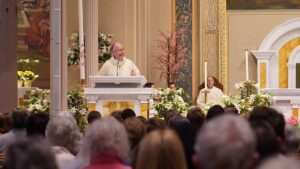
In welcoming the many faithful who came to the Mother Church of Scranton to attend the special memorial liturgy, Bishop Bambera stated the Eucharistic celebration for the Tuesday of the Octave of Easter offered an opportunity to “remember in a very special way our Holy Father, Pope Francis, who was called home to the Lord just yesterday.”
The Bishop continued by inviting the congregation to join him “with gratitude in our hearts for the blessing of (Pope Francis’) ministry, for the gift of his life, and for all that he expended on behalf of the Church of Jesus Christ.”
In assuming the name Francis for his papal title, Pope Francis set the tone for his papacy by honoring the selfless, simple ministry and way of life of Saint Francis of Assisi.
The beloved Pontiff’s characteristic geniality, always evident through his signature servant leadership and as a champion for the downtrodden and those most in need of God’s mercy, was also reflected in his papal motto, Miserando atque eligendo, meaning “lowly but chosen.”
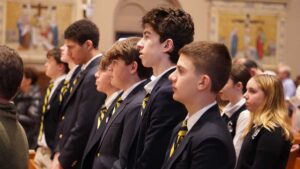
Among those mourning the Pope’s passing, while honoring his enduring legacy of humble service and welcoming, affable nature – much like a lovable brother, father or grandfather – was Ann Marie Sadowski, a member of Saint Patrick Parish in West Scranton.
“I’m here today because I can’t be in Rome to mourn our Pope. This is as close as I can get,” she said. “Like everyone, I was praying for his recovery and I was so happy to see him on the balcony at Saint Peter’s for Easter Sunday. We all thought he was improving since he was able to be out there to bless the people.”
More than 250 people attended the Remembrance Mass at the Cathedral of Saint Peter.
For Donna Wright of Saint Vincent de Paul Parish in Dingman’s Ferry, the Mass for Pope Francis was a fortunate coincidence, since she had made the trip to Scranton for her monthly spiritual direction meeting at The University of Scranton.
“I learned about the Mass on the diocesan website and I just happened to be in the area today. It was a great opportunity to honor our Pope,” Wright remarked. “He really was a Pope for the people — all the people — especially the less fortunate and disadvantaged.”
She continued, “I admired him since he first came out to welcome the people after he became Pope. He was always so humble and down to earth, and I think he was a great example of how to work with those who don’t agree with you.”
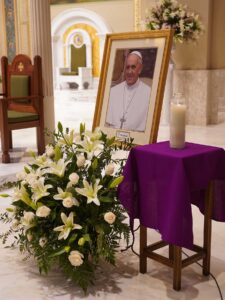
In what proved to be an historic election to determine the 266th Successor to Saint Peter, Pope Francis, then as the 76-year-old Cardinal Archbishop of Buenos Aires, Argentina, was elevated to the papacy in March 2013 to become the first Jesuit and first native of the Americas to lead the Roman Catholic Church.
His 12-year pontificate began and ended with his trademark humility and earthy demeanor, eschewing the traditional pomp, rights and privileges associated with the role of Bishop of Rome.
Saint Peter Cathedral parishioner Pablo Vizcarrondo shared that he usually attends the 6:30 a.m. daily Mass at the Cathedral, but felt it was important to attend the day’s Remembrance Mass for Pope Francis.
“I feel like there are special blessings by being here today for this Mass,” he remarked, claiming to be “a big fan” of Pope Francis. “I liked his ideas in supporting equality for all, especially for migrants.”
Fellow Cathedral parishioners Burlin and Ann Atanasoff of South Abington Township were “honored to be able to attend the memorial Mass for such a wonderful Pope and man.”
“We are here to pray for his soul, and also to pray for his successor,” Ann said. “It’s a sad day, but also a joyous day because we know that heaven has gained a saint.”

